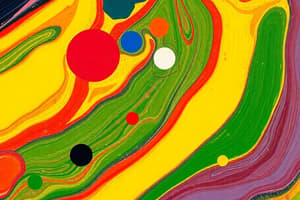Podcast
Questions and Answers
What is the result of PRPP accumulation and stimulation of purine nucleotide production?
What is the result of PRPP accumulation and stimulation of purine nucleotide production?
- Breakdown into purine nucleotides
- Increased risk of urolithiasis
- Formation of calcium pyrophosphate crystals
- Triggering of gouty arthritis (correct)
Which condition could arise as a result of hyperuricemia?
Which condition could arise as a result of hyperuricemia?
- Osteoarthritis
- Calcium pyrophosphate crystal deposition disease
- Rheumatoid arthritis
- Urolithiasis (correct)
What is another name for Calcium pyrophosphate crystal deposition disease (CPPD)?
What is another name for Calcium pyrophosphate crystal deposition disease (CPPD)?
- Hyperparathyroidism
- Hemochromatosis
- Pseudogout (correct)
- Gouty arthritis
What is the most common genetic component associated with CPPD?
What is the most common genetic component associated with CPPD?
Where do calcium pyrophosphate crystals deposit in CPPD?
Where do calcium pyrophosphate crystals deposit in CPPD?
What is the main adverse effect of Colchicine?
What is the main adverse effect of Colchicine?
Why can Allopurinol precipitate an attack of gout at the beginning of therapy?
Why can Allopurinol precipitate an attack of gout at the beginning of therapy?
Which of the following coenzymes supplies C, H, O, and N during purine de novo synthesis?
Which of the following coenzymes supplies C, H, O, and N during purine de novo synthesis?
What is the mechanism of action of Uricosurics?
What is the mechanism of action of Uricosurics?
Why is patient blood count monitoring necessary with Colchicine?
Why is patient blood count monitoring necessary with Colchicine?
How does aspirin help in the beginning of Allopurinol therapy?
How does aspirin help in the beginning of Allopurinol therapy?
What enzyme is used to transfer an N to phosphoribosyl pyrophosphate during purine de novo synthesis?
What enzyme is used to transfer an N to phosphoribosyl pyrophosphate during purine de novo synthesis?
Which nucleotide is the end product of purine de novo synthesis?
Which nucleotide is the end product of purine de novo synthesis?
Which medication competitively inhibits xanthine oxidase?
Which medication competitively inhibits xanthine oxidase?
Which nucleotide base is built on the N in phosphoribose during purine de novo synthesis?
Which nucleotide base is built on the N in phosphoribose during purine de novo synthesis?
What is the general structure (number of rings) of purines?
What is the general structure (number of rings) of purines?
Which of the following statements is true regarding pyrimidines?
Which of the following statements is true regarding pyrimidines?
Adenosine triphosphate is an example of which type of nucleotide?
Adenosine triphosphate is an example of which type of nucleotide?
Which of the following is analyzed in a synovial fluid analysis?
Which of the following is analyzed in a synovial fluid analysis?
In which situation is synovial fluid analysis typically done?
In which situation is synovial fluid analysis typically done?
Which condition is NOT mentioned as a reason for synovial fluid analysis in the text?
Which condition is NOT mentioned as a reason for synovial fluid analysis in the text?
What should be analyzed under microscopy during synovial fluid analysis to aid in diagnosing gout or pseudogout?
What should be analyzed under microscopy during synovial fluid analysis to aid in diagnosing gout or pseudogout?
Why is reciprocal control between ATP and GTP important in the synthesis of AMP and GMP?
Why is reciprocal control between ATP and GTP important in the synthesis of AMP and GMP?
What is the primary function of the purine salvage pathway in nucleotide synthesis?
What is the primary function of the purine salvage pathway in nucleotide synthesis?
What is the role of Hypoxanthine-guanine phosphoribosyl transferase (HGPRT) in the salvage pathway?
What is the role of Hypoxanthine-guanine phosphoribosyl transferase (HGPRT) in the salvage pathway?
What is the main difference between pyrimidine and purine nucleotide synthesis pathways?
What is the main difference between pyrimidine and purine nucleotide synthesis pathways?
What are the substrates required for initiating pyrimidine ring formation in de novo synthesis?
What are the substrates required for initiating pyrimidine ring formation in de novo synthesis?
What is the significance of reciprocal control mechanisms in nucleotide biosynthesis pathways?
What is the significance of reciprocal control mechanisms in nucleotide biosynthesis pathways?
Which enzyme is responsible for attaching phosphoribose to adenine in the purine salvage pathway?
Which enzyme is responsible for attaching phosphoribose to adenine in the purine salvage pathway?
Synovial fluid analysis is a good test to distinguish between an acute flare of _______ and septic arthritis
Synovial fluid analysis is a good test to distinguish between an acute flare of _______ and septic arthritis
Flashcards are hidden until you start studying
Study Notes
Nucleotide Metabolism
- Nucleotides consist of a sugar molecule (ribose or deoxyribose), a phosphate group, and a nitrogenous base (purine or pyrimidine)
- Purines (double ring structure): adenine (A) and guanine (G) found in DNA and RNA
- Pyrimidines (single ring structure): cytosine (C), thymine (T), and uracil (U), with T only in DNA and U only in RNA
- Nucleosides: sugar + base (e.g., adenosine = adenine + ribose)
- Nucleotides: nucleoside + 1-3 phosphates (e.g., adenosine triphosphate)
Purine Nucleotide Biosynthesis
- De novo synthesis: glutamine is used to transfer an N to phosphoribosyl pyrophosphate (PRPP)
- IMP (inosine monophosphate) is the nucleotide product, which can be converted to AMP or GMP
- Salvage pathway: uses hypoxanthine, guanine, and adenine bases, adding phosphoribose from PRPP to form IMP, GMP, or AMP
- Enzymes: hypoxanthine-guanine phosphoribosyl transferase (HGPRT) and adenine phosphoribosyltransferase (APRT)
Pyrimidine Nucleotide Synthesis
- De novo pathway: involves making an intermediate pyrimidine ring, then attaching a ribose-5-P from PRPP
- Substrates: carbamoyl phosphate (made from glutamine, ATP, and CO2), and PRPP
Crystal Arthropathies
Gout
- Hyperuricemia can cause urolithiasis and gouty arthritis
- Management: colchicine, allopurinol, and uricosurics (e.g., probenecid)
Pseudogout (Calcium Pyrophosphate Crystal Deposition Disease or CPPD)
- Epidemiology: common, prevalence increases with age
- Etiology: sporadic, autosomal dominant, or associated with hyperparathyroidism, hemochromatosis, and diabetes
- Pathology: crystals deposit in joint matrix, eliciting inflammation
- Clinical features: can be asymptomatic, asymmetric, and monoarticular or polyarticular
- Treatment: symptomatic, no therapy prevents damage
Synovial Fluid Analysis
- Done to distinguish between septic arthritis, gout, pseudogout, hemarthrosis, and rheumatic joint diseases
- Analyze crystals, cells (RBCs and leukocytes), and culture for microorganisms
Pharmacologic Agents for Gout
- Colchicine: terminates an attack, reduces frequency of attacks; adverse effects: bone marrow depression, nausea, vomiting, abdominal pain, and diarrhea
- Allopurinol: competitive inhibitor of xanthine oxidase, useful prophylactically and acutely; can precipitate an attack at the beginning of therapy
- Uricosurics (e.g., probenecid): block tubular reabsorption of uric acid, increasing excretion; useful prophylactically and acutely
Studying That Suits You
Use AI to generate personalized quizzes and flashcards to suit your learning preferences.





